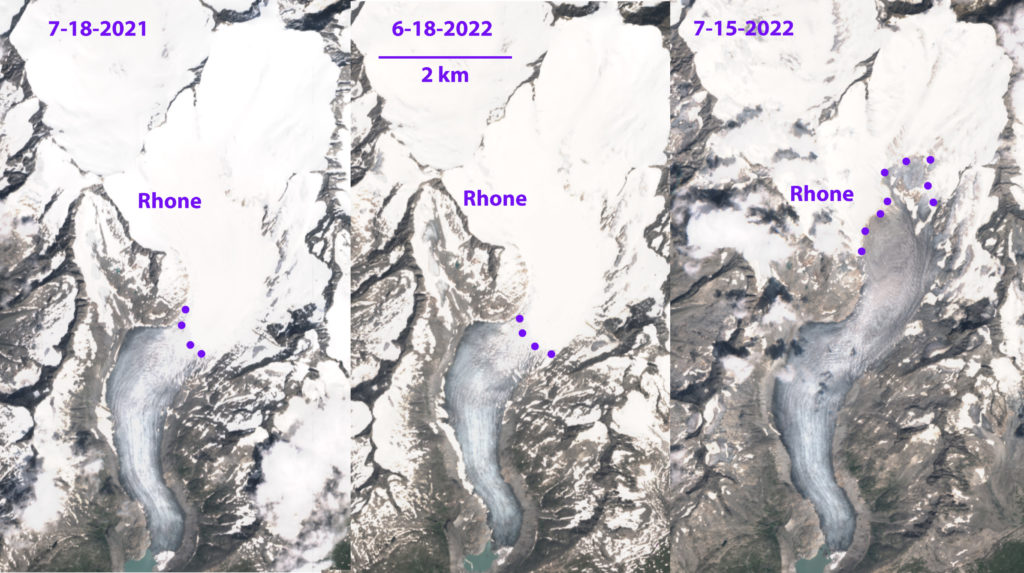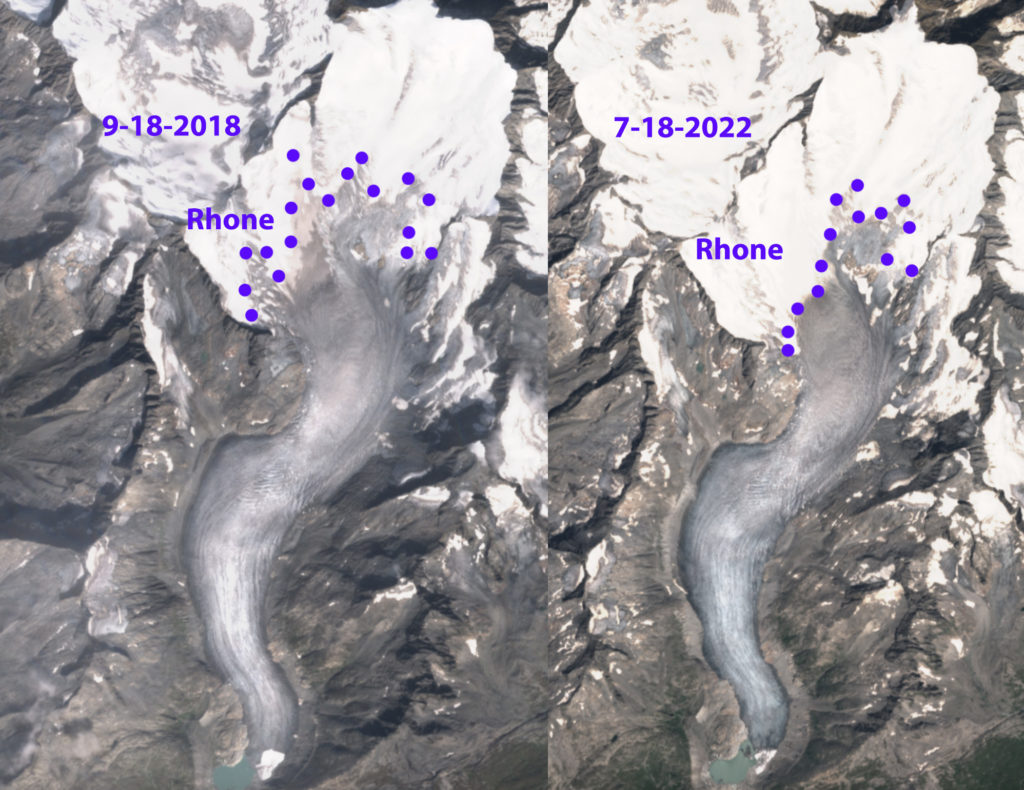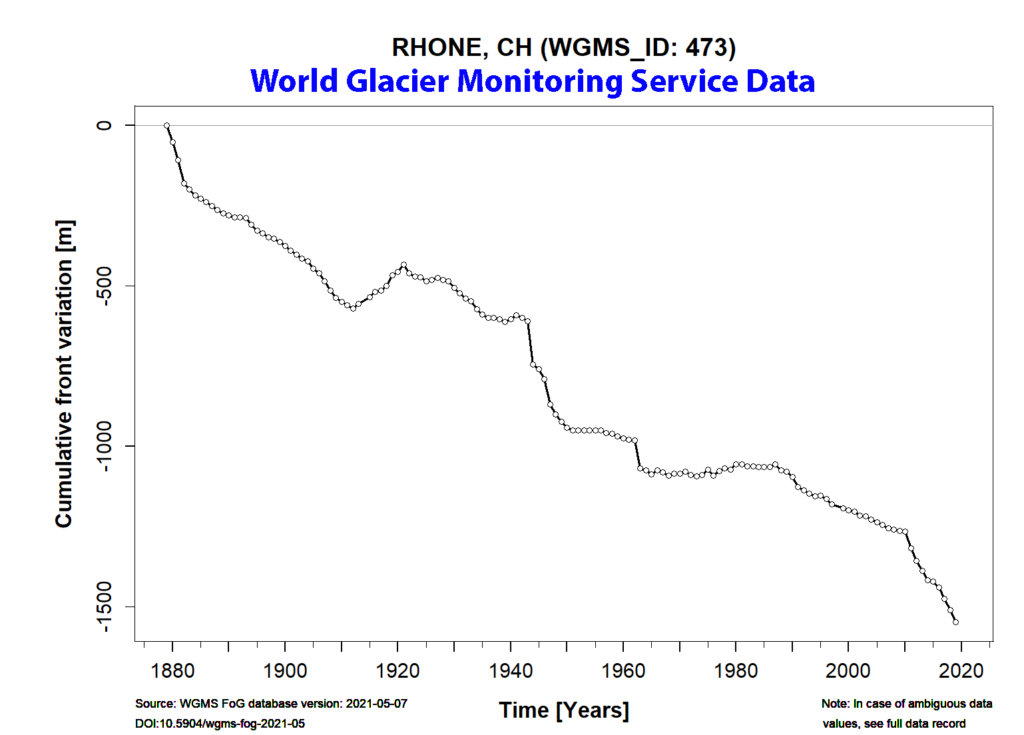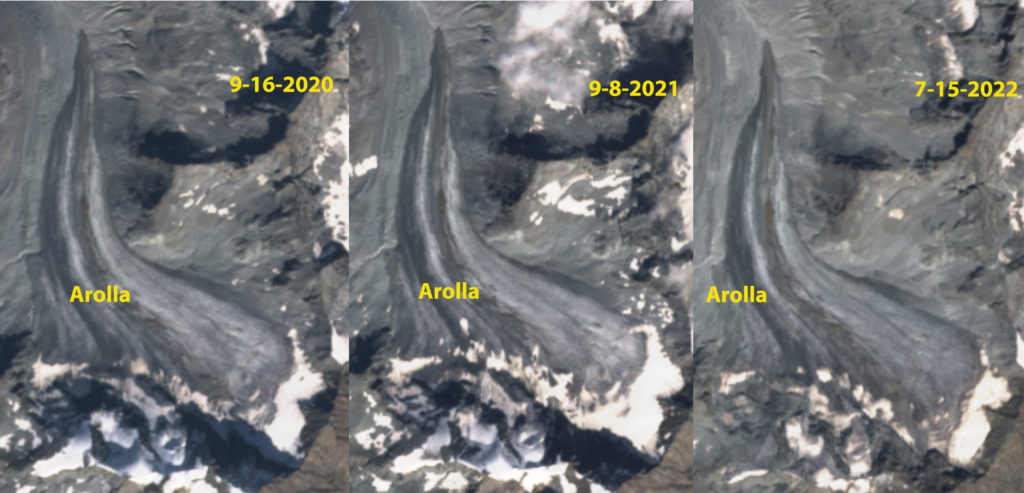July 19, 2022
Swiss Alps Exceptionally High Glacier Snowlines Mid-July 2022
Posted by Mauri Pelto
Rhone Glacier snowline at end of 2003 melt season, July 9, 2022 and July 17, 2022.
Rhone Glacier Sentinel images indicating the snowline position mid July 2021 and 2022 and mid-June 2022.
Rhone Glacier Sentinel images indicating the snowline position at the end of the melt season in 2018 and July 18, 2022.
Rhone Glacier is a temperate valley glacier and is the primary headwaters for the Rhone River. Easy access to this glacier has resulted in terminus observations since 1880 (GLAMOS, 2021). From 1880-2020 the glacier has retreated 1575 m. The glacier experienced a minor advance from 1963-1987. From 1988-2020 retreat has been continuous totaling 520 m (GLAMOS, 2021; WGMS). This has been driven by ongoing mass balance losses, 15 consecutive years from 2007-2021, the entire period of record. Currently the glacier terminates in an expanding proglacial lake. The Glacier Monitoring in Switzerland (GLAMOS), led by Matthias Huss is the most comprehensive of any nation in the world, and their documentation of this exceptional summer of melt will be vitally important. Here we examine the snowline on the Rhone Glacier this summer compared to 2003 and 2018 the previous most extensive melt years.
In 2003 the snowline at the end of the melt season averaged 3100 m, there is a considerable area of firn above the bare ice line in the Landsat image. In 2018 the end of summer snowline averaged 3150 m. In mid-July 2021 a relatively average year the snowline is at 2800 m. The mid-June 2022 snowline is already at 2800 m, by July 9 the snowline has reached 2950 m, rising to 3050 m by July 17 and 18 2022. This post will be updated in one week with additional imagery illustrating the snowline position at the end of the heat wave. The rate of rise of the snowline during the recent heat waves can be used to determined ablation when the balance gradient is known (Pelto, 2011). There is relatively little firn exposed below this elevation, just bare glacier ice, because the snowline has often reached this elevation in recent years stripping the glacier down to bare glacier ice. In the six weeks as the snowline rises, there will an area of firn exposed. The problem for the glaciers as we have seen over and over in recent summers is the loss of snowpack early in the summer, results in greater exposure of the more rapidly melted glacier ice, compared to snow (Pelto, 2022). In the case of Haut d’Arolla Glacier and many other Austrian, French and Swiss alpine glaciers, by mid-July 2022 there is little snowpack remaining. This will increase mass loss. The increasing frequency and intensity of heat waves and their impact on glaciers has been a point of emphasis for our research.
Rhone Glacier retreat data from WGMS.
In 2003 the snowline in Landsat image is at m near the end the ablation season. On Sept. 18 2018 the snowline reached its highest elevation averaging 3100 m. On July 18 2021, the snowline on Rhone Glacier was at 2800 m, a typical elevation. On June 18, 2022 the snowline had already reached 2800 m, a month earlier than in 2021. By July 15, 2022 just as the latest heat wave was beginning the snowline had risen to an average of 2950 m.
Arolla Glacier snowline end of summer 2020 and 2021 and mid-July 2022 in Sentinel images.







 Dean of Academic Affairs at Nichols College and Professor of Environmental Science at Nichols College in Massachusetts since 1989. Glaciologist directing the North Cascade Glacier Climate Project since 1984. This project monitors the mass balance and behavior of more glaciers than any other in North America.
Dean of Academic Affairs at Nichols College and Professor of Environmental Science at Nichols College in Massachusetts since 1989. Glaciologist directing the North Cascade Glacier Climate Project since 1984. This project monitors the mass balance and behavior of more glaciers than any other in North America.
[…] neve na geleira estava localizada a 2.950 metros (9.700 pés) – cerca de 150 metros (500 pés) acima do normal para esta época do […]